Sleeping in the Forest: Stories and Poems (Middle East Literature In Translation) Paperback
https://www.hurriyet.com.tr/gundem/burgazli-sait-faik-amerika-da-yayinlandi-38711164
Sleeping in the Forest: Stories and Poems (Middle East Literature In Translation) Paperback
https://www.hurriyet.com.tr/gundem/burgazli-sait-faik-amerika-da-yayinlandi-38711164
by Doğan Hızlan,
May 12, 2006
A hundred years have passed since the birth of Sait Faik Abasıyanık, who created one of the turning points of Turkish storytelling.
It is still read, it is still cited as an example for young writers.
The Sait Faik Story Award , which is jointly organized by Darüşşafaka Society and Yapı Kredi Publishing every year , was presented to Refik Algan with his book Clock Tower-Short Texts and Stories at a ceremony held at Feriye Restaurant at 19.00 yesterday evening . Sevengül Sönmez in the May issue of the library magazine for those who want to get encyclopedic and alphabetic information on Sait Faik Abasıyanık .
I can recommend the A to Z Sait Faik-Sait Faik Guide prepared by .
Regarding Refik Algan ‘s work, Selim İleri says:
“Refik Algan is a very diverse prose writer who shows poetic rigor in his copywriting… What attracts me is the tangible emotional equivalents of these short texts in life…
A very subtle, hidden ‘humor’. ‘It is certain that convey a sense of … ”
this year Sait Faik Abasıyanık’ s ” Book of Stories published while he was alive ” as a single volume in a stylish paperback ” It’s a Stories in ” under NPMPublished by.
* * *
I hope many people will join the call of a COMMON invitation:
” We are waiting for those who love Sait Faik to the commemoration programs on the 100th anniversary of his birth.”
Friends of the Island Association, Writers’ Union of Turkey, Darüşşafaka Society, Adalar Municipality.
I should remind you of the note “All our events are open to the public” on the invitation .
Yesterday , parts of his poems and stories were read and cartoons were exhibited at the Cemal Reşit Rey Concert Hall .
Our “Universal Storyteller” at the Adalar Water Sports Club in Burgazada on Sunday, 14 May 2006, between 11:00 and 13:00 .A panel will be held.
The 28th Kalpazankaya Commemorative Program will also be held at Kalpazankaya Country Casino .
* * *
Unless you read SAİT FAIK ABASIYANIK , you cannot understand Istanbul, Beyoğlu, the Islands, minorities, and cosmopolitan Istanbul.
https://www.hurriyet.com.tr/sait-faik-100-yasinda-4400713
© Copyright photo by Levent Ağaoğlu
The magnificent Blue Mosque overlooking Hagia Sophia behind sycamore leaves is an aesthetic masterpiece. An unforgettable architectural masterpiece from centuries beyond, with a chestnut kebab vendor of 1970s car models at the entrance. Blue Mosque 11 October 1975
Çınar yaprakları ardında Ayasofya’ya nazır görkemli Sultanahmet Camii estetik şaheser. Giriş kapısında 1970’lerin araba modelleri kestane kebap satıcısı ile yüzyıllar ötesinden unutulmaz mimari bir şaheser. Sultanahmet Camii 11 Ekim 1975
…………………………………………………
by Doğan Hızlan
I received an important fax from Ambassador Metin Göker , Director General of Cultural Affairs at the Ministry of Foreign Affairs . There is also the Blue Mosque -which is listed as the Blue Mosque- in Millennium’s 10 Ball Buildings , published in New Zealand’s most respected and important weekly magazine, The Listener .
The 10 buildings of the millennium are listed as follows:
Taj Mahal: The tomb built by the Turkish-Indian ruler Shah Cihan (1592-1566) for his wife Mumtaz Mahal (Ercüment Banu Begüm). 20,000 workers worked for 22 years.
Sagrada Familia: Antoni Gaudi ‘s unfinished Holy Family church in Barcelona .
Chrysler Building: Described as the queen of New York skyscrapers.
Potala Palace, Lhasa: This building, which is called the Godzilla of religious buildings, was completed in the 17th century by the Dalai Lama’s palace in Lhasa, which was the capital of Tibet.
Sydney Opera House: This opera house, whose plan was drawn by John Utzen , is defined as the most modern, most magnificent and functional opera house in the world.
Chartres Cathedral: This cathedral in France is the first and largest of the medieval churches. It took its final shape in 1220.
Pompidou Center: It entered this list with its decoration and technology. The most loved and used art center in Paris.
Ulm Cathedral: This building in Ulm , Germany is a symbol of Gothic architecture.
Blue Mosque (Sultanahmet Mosque): The most beautiful mosque in the Islamic world. A mosque completed by the famous architect Sedefkár Mehmed Ağa in 1616.
Bilbao Guggenheim Museum: This museum, which left its mark on Frank Gehry ‘s modernism of the century, was built in Bilbao , the fourth largest city in Spain .
SOME of our readers may ask why not the Süleymaniye Mosque .
According to some historians, Sultanahmet ‘s pioneering in the art of decoration may have played a role against the simplicity of Süleymaniye .
His tiles, reflecting light, may have attracted much more attention from foreign experts. Moreover, the first silhouette that appears when coming from Marmara is that mosque.
I think what Doğan Kuban wrote on the Blue Mosque explains the reason for this choice:
The Sultan Ahmed Complex, realized by ‘Master Architect Sedefkár Mehmet Ağa’, is the last comprehensive project that can be compared with 16th century buildings.
The Yeni Mosque and Sultan Ahmed Mosque, built by Sinan’s students, took the Şehzade Mosque as an example and made variations of it. This choice is important for Turkish architectural history, and it probably proves that their master Sinan and they, and even their patrons, preferred the Şehzade scheme to Süleymaniye.’
The fact that the Taj Mahal is among the 10 structures is also interesting in terms of our architectural history. This tomb, which was built by the Indo-Turkish Emperor Shah Cihan for his wife Mumtaz Mahal (Ercüment Banu Begüm), is considered an important work of Turkish-Islamic architecture.
Suut Kemal Yetkin gives the following information about the architect of the Taj Mahal :
‘The architect of the Taj Mahal, which is one of the world’s leading masterpieces in terms of cleanliness in its lines, harmony in its mass and suitability to its theme, is the son of Turkish architect Yusuf, who was brought up by Koca Sinan and who was called to India.’
***
I think this list summarizes the adventure of all architectural lines in the world over a thousand years.
***
Referenced sources:
Istanbul An Urban History- Byzantion, Constantinople, Istanbul, Doğan Kuban, Translation: Zeynep Rona, Turkish Economic and Social History Foundation.
Art in Islamic Countries, Suut Kemal Yetkin, Cem Publishing House Encyclopedia of Yurt, Great Larousse-Dictionary and Encyclopedia.
Suut Kemal Yetkin and two great encyclopedias agree that the architects and masters who went to India were Turkish, but their names are different. We took the names in Yetkin’s work.
https://www.hurriyet.com.tr/dogan-hizlan-sultanahmet-camii-milenyum-saheseri-39091894
by Ali Yaycioglu
From the 11th to the 16th centuries, it was not possible to separate Iran (Diyar-ı Acem) and Asia Minor (Diyar-ı Rum) with sharp boundaries from each other. The cultural interaction between them continued in a wide range from literature to religious understandings. Two centuries of conflict between the Ottoman and Safavid Empires, which began in the 16th century, led to the separation of Anatolia and Iran. But these boundaries were never as sharp and precise as the two sides claimed. From Iraq to Basra, the cities, khanates, emirates, principalities, tribes, and sects in this vast area remained within the dual sphere of influence of the Ottomans and Safavids, or coexisted and ruled both empires.
Of course, apart from Turkey, I am not only interested in Iran. The vast Ottoman geography, especially Greece and the Balkans, was always the main focus of attention for me. Probably one of the most important things that an Ottoman historian who came out of Turkey should do is to get out of Turkey at the first opportunity he gets, and to travel in the Balkans, the Crimea and the Arab geography, if possible, to spend a long time there. Since the second half of the 1990s, when I decided to become an Ottoman historian and started to embrace this job, I wandered around the vast Ottoman geography as much as the wars that turned the Balkans and Arab World upside down. In the places I went, I got stuck in the archives and made friends.Although I could not learn properly, besides Arabic and Greek, the two languages of the Ottoman Empire that were common after Turkish, I became involved with the Balkan languages for a while. I would like to write about these geographies where I spend time in future articles in Oxygen.
But Iran was always in a different place. Although it has many similarities with Turkey, where I was born and grew up, and the Balkan and Arab geography that I keep visiting, Iran was not Ottoman. In fact, it was in contradiction with some elements of the Ottoman cultural geography. For this very reason, when I had the pleasure of looking at the Ottoman world from Iran and contemplating the history of the Ottoman Empire – and post-imperial Turkey, the Balkans and Arab countries – through Iran, Iran became a world that I can’t get enough of. However, I would like to note the following; The histories of countries, such as the history of Iran or Turkey, actually somewhat hide the complex stories of those geographies that do not fit into a single historical narrative. Country histories are often narratives of geographies that have always existed and that shape and even create the people living on them. For that reason,Perhaps the first condition to be interested in and love a country is to question the “historical” narrative of that country.
How about a little history chat? As I stated in the previous article, it was not possible to separate Iran (Diyar-ı Acem) and Asia Minor (Diyar-ı Rum) from each other with sharp borders from the 11th to the 16th centuries. Those who read a little about the middle ages of these two geographies should not be difficult to appreciate the existence of a cultural corridor stretching from Khorasan to the Balkans – in fact, it may not be wrong to extend this corridor as far as northern India. The pleasure of observing how Persian and Turkish together and influencing each other shape the political and cultural world in this vast geography is not unique to literary historians. Seljuk, İlhanlı and Timur Empires realized this political union of Iran and Anatolia up to a point.But the entangled histories of Diyar-ı Acem and Diyar-ı Rum are undoubtedly too rich and complex to be reduced to the empires’ claim to political unity. The endless population movements between Anatolia and Iran for centuries created a dizzying cultural interaction area. This cultural interaction continued for many years in a wide range from literature to visual arts and architecture, from political institutions to natural philosophy, from religious understandings to cosmology.continued for many years in a wide range from religious understandings to cosmology.continued for many years in a wide range from religious understandings to cosmology.
The two-century conflict between the Ottoman and Safavid Empires, which started in the 16th century, will cause the separation of Anatolia and Iran and the drawing of borders. After the 16th century, the cultural identity of these two geographies developed in a way opposite to each other. But these boundaries were never as sharp and precise as the Ottomans or Safavids claimed. From the Caucasus to Kurdistan, from Iraq to Basra, the cities, khanates, emirates, principalities, tribes and sects in this vast border area continued to remain in the dual sphere of influence of the Ottomans and Safavids, or to coexist and rule both empires. .
Despite this, I think we can argue that the common history of Iran and Anatolia, along with the Ottoman-Safavi rivalry, split into two different branches. The biggest factor in this separation was the conflict between the Ottoman and Safavid empires and the rivalry between Sunnism and Shiism. In fact, from the 12th to the 16th centuries, this vast geography, from Iran to Anatolia, witnessed many Sufi movements that did not fit into the framework of Sunnism and Shiism, and was knitted with networks of different sects shaped around religious leaders whom the people ascribed holiness. These Sufi movements formed partnerships with elites, mostly Turkish-speaking, who held political and military power. As a matter of fact, the Ottoman and Safavid states are the result of the partnership of these veterans and Sufis, political/military and spiritual charisma, even if they are about 150 years apart.
At the beginning of the 1500s, when the Safavid Empire emerged in Iran, the Ottoman Empire had already flourished in the Balkans and Western Anatolia; He survived Timur’s attempt to annex Anatolia to the great Eurasian Empire he wanted to establish; He had conquered Constantinople and settled in the legacy of Eastern Rome, and moreover, he had annexed the Crimean Gerays, the heirs of Genghis Khan, and began to dominate the complex geography of Anatolia.
At the beginning of the 1500s, when the Ottoman Empire was heading east, the Safavi State was established with the support of the Kızılbaş-Turkmen tribes, who gathered around the spiritual and political charisma of Shah İsmail on the legacy of the Akkoyunlu Turkmen Confederation and held the military power. This will also trigger the start of Iran’s widespread Shiiteization process. Iran’s Shiiteization is in itself a very interesting and rapid but complex social transformation. It is almost a “miracle” that the geography of Iran, where the Shiite people are in the minority, has become Shiite collectively in such a short time. In the words of Abbas Amanat, it would not be easy to associate this “Safavi revolution” with Shah Ismail’s messianic charisma, which soon gathered thousands of people from different ethnic groups, beyond social expectations.
In the meantime, Ismail’s representatives, who carried his religious charisma to the Ottoman lands, became influential in Anatolia, and as a result, the Şahkulu Revolt broke out in the Turkmen tribes spread over the foothills of the Taurus Mountains, against the authority that the Ottoman Empire had just begun to establish in Anatolia. In this context, Yavuz, who did not find a war against Shah Ismail irrational, was defeated by his father II. He revolted against Bayezid, and emerged victorious with his supporters from the internal rivalry between the Ottoman dynasty and state elites. Selim’s murder of thousands of people in Anatolia on the grounds that he was a supporter of Shah Ismail and “Rafizi” in the period from his accession to the throne in 1512 until the Battle of Çaldıran in August 1514, when he met Shah Ismail, is one of the bloodiest events in the history of Turkey, the effects of which have continued to this day. .
The religious charisma of Shah Ismail, the founder of the Safavid state, is well known. Shah Ismail’s father is Sheikh Haydar, who is a descendant of Sheikh Safi from Ardebil. And from here the Safavids sent themselves to the 7th Imam Musa al-Kazim, and from there to the Prophet. Tied to Ali. Of course, Shah Ismail’s claim to spirituality decorated with messianic elements gave him strength beyond this sacred genealogy.
The dimension that is not emphasized much is the “Imperial” charisma besides the religious charisma of Shah Ismail. Shah Ismail’s mother is Halime Begüm, also known as Martha. Begüm/Martha is the daughter of Akkoyunlu ruler Uzun Hasan and Theodora Komnena, a descendant of the Eastern Roman Emperors. Theodora is the Greek Emperor of Trabzon IV. She is the daughter of Ioannis Komnenos. In other words, Shah Ismail does not claim to be descended only from the Prophet of Islam and his descendants. He also combines the Eastern Roman Empire tradition in his political charisma through his grandfather Uzun Hasan and Oguz-Turkmen and his mother Halime Begüm. Shah Ismail is exactly the leader produced by the entangled history of Anatolia and Iran.
With the Battle of Çaldıran in 1514, Yavuz defeats İsmail and, as a result of the initiatives of İdris-i Bidlisi, who grew up under the Akkoyunlu administration in Iran, he makes agreements with the Kurdish Emirates that recognize their regional autonomy. Following this, it goes south and ends the Mamluk Sultanate, one of the most interesting political structures in Islamic history, and its three holy cities; He annexes Jerusalem, Mecca and Medina, and of course Egypt, to the Ottoman empire. Maybe this way, the Portuguese, who showed their influence in the Indian Ocean, will be prevented from going to the Arabian peninsula and occupying the Hejaz. It is probably a much later myth that he received the title of caliphate in a ceremony in Hagia Sophia from Mutevekkil III, who is claimed to be the last Abbasid caliph brought to Istanbul from Egypt.But within five years, starting with Çaldıran and ending with the annexation of Egypt, the Ottoman Empire ceased to be a Balkan-Anatolian union: it became an Afro-Eurasian empire, which included the holy cities of the Arab world and Islam, and the majority of the population in the geography it ruled was Sunni Muslims. This would also change Ottoman political thought and the historical and religious role that the empire attributed to itself.
In fact, there are interesting similarities between the transformation of the Ottoman and Safavid empires, albeit with a difference of 100 years. The Gazi-Turkmen tradition, which was prominent in the early periods in both empires, was gradually eliminated from the central administration, instead new military and bureaucratic elites organized around the dynasties and mostly composed of later Islamized servants came to the fore. Likewise, the mystics, who played an active role in the establishment of these states, left their effective position to the Sunni ulama in the Ottoman Empire, and the Shiite ulama in Iran, which began to bureaucratize. Yet in both worlds, neither the tribes and other local powers that contradict the centralized state, nor the sects operating on a wide spiritual and social spectrum disappear. On the contrary, with many new actors from the 17th century, tribes,local dynasties and sects begin to play a role again in the fate of the two empires.
The relations between Safavi Iran and the Ottoman Empire after the mid-16th century, yes, in a way, is the common story of Iran and Anatolia, but also of the Caucasus, Kurdistan and Iraq; but it is also part of global geopolitics. Ottoman-Habsburg rivalry in the Mediterranean and Europe generates different global alliances. The Habsburgs, with Safavi Iran, the rival of the Ottoman Empire; The Ottomans form alliances with the Habsburg rivals, the Kingdom of France and the Protestants of Central Europe, and Iran’s other rival, the Uzbek Khanate. Major geopolitical changes also open the door to new religious and cosmological quests. The apocalyptic excitements that started to spread from Iran to Iberia in this period are colored by the messianic claims of Suleiman the Magnificent, through the door opened by Shah Ismail.
But subject states could not establish full political, religious-ideological, or financial-administrative control in the lands they ruled. Despite the Sunnization attempts in the Ottoman world, pro-Shia and Safavid tendencies did not disappear. Similarly, the Sunni people, who did not dissolve despite the Shiite attempts of the Safavid regime, followed the Ottomans from Iran and waited for the moment when they would rise up. Just as the Moriscos, who were converted to Islam in Spain – but some of them secretly retain their Muslim beliefs – followed the Ottomans from afar and dreamed that one day they would conquer Spain and even America after Rome.
I was going to write about Isfahan this week. But it didn’t happen as you can see. I could not get up to speed and plunged into the Ottoman-Safavi rivalry of the 16th century. Of course, what I wrote is just a rough and very limited summary of a very large and complex history. I will write Isfahan next week. Why is Isfahan so important? Yes, just as it is necessary to study Istanbul first in order to understand the Ottoman Empire, I guess, to understand Safavi Iran, one must first understand Isfahan and the story of its transformation into the center of the Safavid state. However, while describing Isfahan, it is impossible not to mention Kashan, Shiraz, Yazd, Tabriz and of course Mashhad. Tehran, on the other hand, consisted of a small town established on the site of the city of Rey, which was destroyed by the Mongols at that time.
by Doğan Hızlan
The increasing interest in archeology in recent years proves that we learn especially about Thrace and Anatolia better, and that the source of many cultures and arts comes from these lands.
* * *
Sevin ‘s work; It covers a period of time from the beginning of these lands (Paleolithic) to their entry into Persian rule. This work includes the Paleolithic Age, Neolithic Age, Chalcolithic Age, Early Bronze Age and Iron Age .
In addition to the text, 66 maps, 600 pictures, 262 drawings and 10 tables strengthen the visuality.
Archaeologist Sevin states in the Foreword how we rediscovered our own culture with the help of archeology:
‘But until yesterday, we could not fully understand this creator in him, we always saw Greece, Rome, Mesopotamia, Egypt, Syria or Crete as the homeland of original cultures and great inventions.
Archaeological discoveries made in the last thirty years have gradually begun to change and correct these preconceived views. It was determined that the transition from caves to the first permanent shelters and villages arose in these lands. It was determined that animals and plants were domesticated here for the first time. It was revealed that the foundations of trade began to be laid here, and the first great cities, temples and stone sculptures were formed here.’
* * *
While reading Ancient Anatolia and Thrace , you will realize how this region, this peninsula, was the land of the firsts in the history of civilization.
Indeed, when one learns these, one acquires the necessary information and gains a perspective in order to view Anatolia from a cultural rather than an ideological point of view, as the researcher said.
* * *
I have come to the conclusion that such a book is a unique resource in determining the place of the country in which he lives in the world, in archeology and in the development of humanity.
Once upon a time, archeology was regarded as the work of archaeologists, and it was not thought of how the excavations changed and enriched the information on the ground.
However, we all know today that it is possible to learn about the past and the present with its cultural identity, especially when it comes to Anatolian lands, through archaeological studies.
Archeology in TurkeyI was happy in two ways: Sevin included the names of those who gave their lives to the establishment, recognition, prestige and interest of archeology in Turkey with their efforts in this branch.
Who ?
Osman Hamdi Bey, Arif Müfid Mansel, Ekrem Akurgal, H. Zübeyir Kosay, U. Bahadır Alkım, Tahsin Özgüç, Halet Çambel, Jale İnan, Nimet Özgüç, Ufuk Esin.
* * *
Wandering through the pages of Ancient Anatolia and Thrace , you will make an informed and entertaining trip.
You come across Tilkitepe , a commercial station on the shores of Lake Van , wander along the Euphrates, into a merchant town, Değirmentepe.Do not neglect Arslantepe , which is described as a palace city in Malatya .
In the pages of Troy Treasures , experience the sadness of losing a fortune that is ours, However, do not forget the pride that Troia is also in these lands.
From Veli Sevin ‘s study of the Hittite Empire , you can once again understand the importance of this empire in a language that everyone can understand.
The Development of Writing – Hittite Language and Writing section informs us about the history of the writing civilization:
‘The Hittites, who called themselves Neşali, used two types of writing, cuneiform and pictorial (hieroglyphic), and called the language they spoke Neşa’ca (neşiumnili).
The number of clay tablets found in the state archives in Boğazköy exceeds 25,000.
Famous Women of Anatolia . The ones in the book show that the beauty symbol women that we portray in our imagination do not match the reality.
Midas see your face ‘ta, King Midas ‘ tomb and how I found the etlendiril can read the story of the skull found.
I think your curiosity will make you ask this question.
Midas’Is the Legend of Donkey Ears true?
It’s true. Midas had long hair on his ears and looked even bigger than usual.
* * * When you finish reading, I have no doubt that you will not be able to avoid some associations about today.
Veli Sevin ‘s Old Anatolia and Thrace book tells us the importance of Anatolian civilization in a plain, understandable language that is not drowned in terms.
Even if you are not interested, this book will make you love archeology.
He will also fall in love with Anatolia.
Veli Sevin was born in Ödemiş in 1944, studied at the Faculty of Letters at Istanbul University.
Head of Archeology Department at Van Yüzüncü Yıl University
https://www.hurriyet.com.tr/arkeoloji-icin-bulunmaz-yol-haritasi-153133
by Doğan Hızlan
Today, it will continue at 10:00 in the same venue and the last talk will end at 12:00.
Previously, a symposium was held in Iran for Báki Hodja . His books were exhibited in the hall of the Library due to the symposium .
On the 800th anniversary of Mevláná ‘s birth, a symposium should really be held for him, thank you to those who thought about it.
He was a great scholar, and he knew how to pass on what he knew to everyone. The teaching aspect was unique, not only while you were reading but also listening, you would realize what a scientist is.
I have no doubt that if Báki Hoca ‘s MevlánáIf it were not for his books on Mevlevi and Mevlevi , Mevláná would not have been read as much, not known as much, accepted as much, and loved so much in our country.
Because he carried the great thinker to the present with his comments and annotations.
While visiting the exhibition, there were some of the books I read most of which took me back years.
* * * When we founded Eti Publishing House with my DEAR friend Konur Ertop , our first book was Simavne Kadisioğlu Şeyh Bedreddin by Abdülbáki Gölpınarlı . My late teacher İsmet Sungurbey also wrote a foreword.
In my publishing career , I had the honor of publishing other books of Hoca .
One day, he came to Altın Kitaplar Publishing House with Yunus Emre’s book in his hand . “You print this book , “ he said, and I, one of the owners of the publishing house, Dr. Turhan Bozkurt gave the answer immediately, “You’re welcome” . Later, Sheikh Galip ‘s Hüsn ü Aşk
We published the. The signature under the dedication in that book, which I kept among my most valued signed books, was: “Bende-i Bendegán-ı Mevláná.” Báki Hoca was a person who followed the new literature, explained his thoughts on them, and sometimes conveyed them through the lens of sharp humor.
Among the contemporary writers of Turkish literature , he liked Orhan Kemal the most . I would like to write one more memory about him. Following the serialization of
Orhan Kemal ‘s novel A Girl from the Streets , Báki Hoca is one of the main protagonists of the novel , Cevdet.‘s prison fell upon reading that, one morning, Orhan Kemal ‘ s house and goes to “rescue this child from prison,” he says.
I don’t remember seeing such a vivid example of reading a work in anyone else.
* * * The works of ABDÜLBÁKİ GÖLPINARLI are still a unique source of information and enlightenment for all of us today.
https://www.hurriyet.com.tr/mevl-n-yi-gunumuze-tasiyan-edebiyat-arkeologu-golpinarli-7507210
1. The Chinese are the oldest neighbors of the Turks.
In the words of the famous French Sinologist Alain Peyrefitte, “Turks and Chinese seem to be in diametrically opposite positions at the two ends of the same giant continent. Yet there are many reasons why they should understand each other. Turkmen horsemen have roamed Asia for twenty centuries. They came from the same Central and South Asian steppes, and shaped history in the Huang Ho (Yellow River) valleys as they did in the Anatolian plateaus. For centuries, Turkmen caravans formed the only link between China and the Western lands. Even today, one of the largest and most populated areas in China where non-Chinese people live is Chinese Turkestan, where Anatolian Turks live by blood relatives.”
The source of the first and most important inventions in the world was China. The printing press, the first simple clocks, the compass, gunpowder, furnace, and many other important inventions were created in the Chinese Empire.
The printing press has been known to the Turks for centuries. In the fourteenth century, the Mongol rulers of Persia issued and issued paper money, clearly in imitation of Chinese patterns. In an earlier date, the Turkish tribes in the Chinese border lands used a type of woodblock printing common in the Far East. But all this has been forgotten for a long time… What civilization did the Turks belong to and in which civilization did their future lie? In a distant and half-forgotten time, the Central-Asian ancestors of the Turks came to a turning point in their history after hesitating between China and Islam and chose the Western alternative… When the Turkish people gave up on China and converted to Islam 1000 years ago, the marches towards the West began.
Although there have been many struggles between the Turks and their neighbors the Chinese, it cannot be denied that the Chinese established one of the most advanced civilizations in the world until the 8th century. For this reason, the Chinese also had constructive effects on the Turks. The Turks had coins minted in the Chinese style. They learned silk making, tile making and paper making from the Chinese and they valued art.
The knowledge and experience coming from Central Asia probably contributed to the fact that the Turks reached the highest level in tile making in Iznik, Anatolia. It is noteworthy that there were 330 tile workshops in Iznik in the 15th century. So much porcelain was imported from China throughout the 17th century that the elegant Iznik tiles that still dazzle us in museums today, could not stand this competition and were withdrawn from the market.
In another example, after the Ottomans made Bursa the capital city, sericulture reached the highest levels in this city, again the products of an old accumulation. Evliya Çelebi mentioned tea in his travelogue and thus cited perhaps one of the oldest documents regarding today’s consumption of this national drink in Anatolia. Tea would certainly come from China via Russia or via Southeast Asia and the Hejaz. With the spread of tea, a large amount of Chinese porcelain also entered the Ottoman Empire.
The prosperous cities of their closest neighbors, the Chinese, who were in the most advanced state in terms of civilization, various elegant goods, wonderful porcelain, deliberate weapons, tools and rich products, especially silk, which were insistently sought in the West, were affecting the Turks. They were right in that too. Aren’t gunpowder, paper, compass always invented in China? Even the printing press.
Chinese elements in Turkish have not been studied yet. In this way, the only thing that has been done so far has been to deal with Chinese written Turkish words and sentences, names of persons and places, in short, Turkish transcribed with Chinese letters. The Chinese elements, which were transferred to Turkish, became the property of Turkish in any region, in any period, and became one of the building blocks of Turkish thought, have not been researched within the criteria of science. What we have on this subject is that various lexicographers ascribe some words to Chinese without any special effort, which they cannot explain in Turkish. For example, M. Rä sä nen cited 147 words in his dictionary as Chinese; However, it is not certain that all the words shown in this dictionary are Chinese, nor that the number 147 is certain.A work dealing with elements from the Chinese of the new eras into Turkish was published in Moscow in 1970. Of course, the determination of quotations between languages is incomparably easier when it comes to the new eras in which writing has become widespread. As a matter of fact, although it is the first study, 1873 Chinese words and forms have been determined in the language of today’s Uighur Turks. This work, as we said, was published in Moscow in 1970 by Rahimovic under the title “Chinese Elements in the Uyghur Language”.This work, as we said, was published in Moscow in 1970 by Rahimovic under the title “Chinese Elements in the Uyghur Language”.This work, as we said, was published in Moscow in 1970 by Rahimovic under the title “Chinese Elements in the Uyghur Language”.
Unfortunately, even the word Turkish elements in Chinese is not an easy word to say. Many researchers have not considered that Turkish elements can be found in Chinese. Of course, there are some reasons for this. The most important of these reasons is that there is a thousand-year period between the oldest written Turkish document we have and the period when Chinese was first written.
While the effect of Arab and Iranian elements in Turkish culture is a well-known subject, a search for the determination of the effects of Central-Far Asian and Chinese elements in the mentioned synthesis should be kept alive on the agenda.
CULTURAL INTERACTION
FROM TURKS TO THE CHINESE FROM THE CHINESE TO THE TURKS
ART Gin Violin (Huqin) Çintamani (Dragon Motif)
Tile
Porcelain
Yin Yang
Hatayi (stylized flower)
LANGUAGE Tea, cloth, wood, silk, tangerine
FOOD Ravioli (Mantou) Tea
Huntun (Wanton) Apricot, Tangerine, Orange
Wine (Yakut Turks) Pasta
MATERIAL Leather Silk
Iron Paper
Could Greek philosophy be rooted in Egyptian thought?
Is it possible that the Pythagorean theory was conceived on the shores of the Nile and the Euphrates rather than in ancient Greece?
Could it be that Western civilization was born on the so-called Dark Continent?
For almost two centuries, Western scholars have given little credence to the possibility of such scenarios.
In Black Athena, an audacious three-volume series that strikes at the heart of today’s most heated culture wars, Martin Bernal challenges Eurocentric attitudes by calling into question two of the longest-established explanations for the origins of classical civilization. The Aryan Model, which is current today, claims that Greek culture arose as the result of the conquest from the north by Indo-European speakers, or “Aryans,” of the native “pre-Hellenes.”
The Ancient Model, which was maintained in Classical Greece, held that the native population of Greece had initially been civilized by Egyptian and Phoenician colonists and that additional Near Eastern culture had been introduced to Greece by Greeks studying in Egypt and Southwest Asia. Moving beyond these prevailing models, Bernal proposes a Revised Ancient Model, which suggests that classical civilization in fact had deep roots in Afroasiatic cultures.
This long-awaited third and final volume of the series is concerned with the linguistic evidence that contradicts the Aryan Model of ancient Greece. Bernal shows how nearly 40 percent of the Greek vocabulary has been plausibly derived from two Afroasiatic languages-Ancient Egyptian and West Semitic. He also reveals how these derivations are not limited to matters of trade, but extended to the sophisticated language of politics, religion, and philosophy. This evidence, according to Bernal, confirms the fact that in Greece an Indo-European people was culturally dominated by speakers of Ancient Egyptian and West Semitic.
Provocative, passionate, and colossal in scope, this volume caps a thoughtful rewriting of history that has been stirring academic and political controversy since the publication of the first volume.
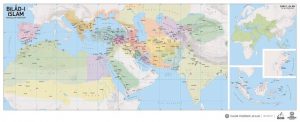

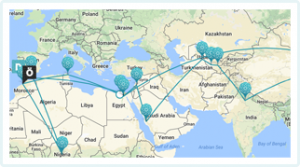

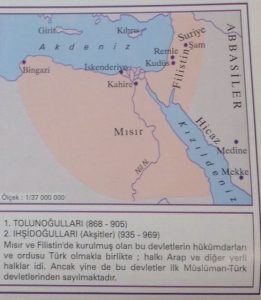
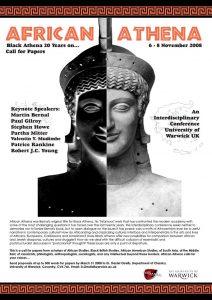
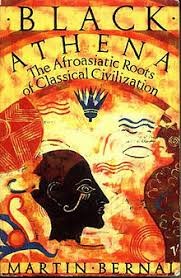

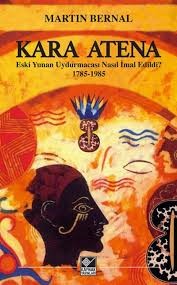
AFRASIA: Why not the Turkey-based AFB Afrasya (Africa-Asia) Union? From Maghreb to Transoxiana…
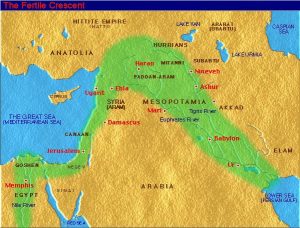
Map 1: Fertile Crescent
Only Asian and African markets are included in the list of 13 biggest growing countries in 2015.
Ranking of countries with the most population in 2100
Africa 5 countries, Asia 4 countries, America 1 country.
Source: Which countries are taking us to a world of 11 billion? World Economic Forum
Population growth in this century will be dominated by Africa. Source: Reddit
The Middle East was the key point of Atlantic Europe/England.
The key point of Pacific Asia is AFRASIA.
The Western family, which the USA “paternized”, has disintegrated. There is no longer a transatlantic cross, but Afrasia, Africa and the Pacific.”
Neither Shanghai,
nor Eurasia,
nor Brussels,
nor the Atlantic
Turkey should form a new union with its unique location at the intersection of 3 continents.
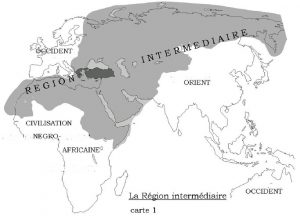
Map 2: Buffer Zone
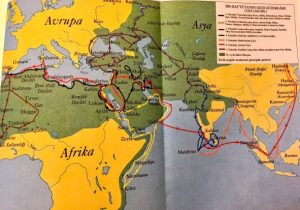
Map 3: Afrasia: Map of Ibn Battuta’s Travels from Africa (Tanji, Morocco)
While the power struggle of UN 5 in Africa continues with England in the east of the continent and France in the west, the main struggle in the Black Continent is between the USA and China.
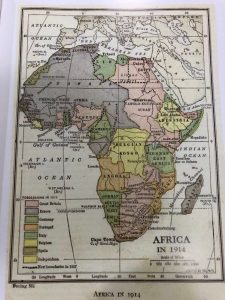
Map 4: Africa 1914
(Source: Kemal Sayar, map of Africa in 1914. A huge continent with German, French, Belgian and British colonies. Look at the names of the countries, British Sudan, Belgian Congo, etc.).
GLOBAL IDEA CENTER- CYPRUS: MEDITERRANEAN CIVILIZATION- AFRASIAN MILLIONNAIRE
Middle of the World The shores of the Mediterranean are surrounded by harbors always overflowing with ideas; Istanbul, Troy, Miletus, Pergamon, Halicarnassus, Athens, Thessaloniki, Izmir, Ephesus, Rome, Barcelona, Beirut, Piraeus, Alexandria, Kyrenia, Famagusta, Paphos, Haifa, Tripoli, Casablanca, Tunisia, Algeria, Assos, Haifa, Jaffa, The ports of Alanya, Alexandria, Latakia and Tartus are the cities where great thinkers grew up.
Universal thinkers such as Aristotle, Plato, Pythagoras, Ibn Bacce, Ibn Tufeyl, Ibn Rushd, Ibn Arabi, Ibn Batuta, Ibn Haldun, İsmail Hakkı İzmirli, Muhyiddin Kafiyeci from Bergama, Ishak Efendi (Chief Hodja), Hilmi Ziya Ülken, Niyazi Berkes. They are the precursors, the treasures of light, of the Afrasia Civilization emerging from
Cyprus, where Time and Grounds intersect, will bring out a universal Mind from the treasure of these intersections and will make it available to all humanity.
Despite the European Hegemony, which used external resources that did not belong to it, but achieved dominance for 500 years; Mathematics and rationality of Asia Minor, symbolized by Miletus; Diophantus mathematics symbolized by Alexandria, Pythagorean wisdom (sophia) and Harezmi mathematics symbolized by Baghdad, wisdom of Beytül Hikme; In the Center of the World, Cyprus, the Afrasia Millennium, which has emerged from its own resources since the beginning of the 21st century, is preparing to take its place in history as the 3rd millennium. The richness of thought of Ancient Egypt, Mesopotamia and Transoxiana is being reshaped on the island of Cyprus.
Cyprus, an island state, has incredible lessons to be learned from these developments. Cyprus is the island of thought;
It will rise to the position of the intellectual center of the Afrasian Millennium by feeding on the legacies of thought.
by Doğan Hızlan
However, Archeology and Art, despite publishing in an area of interest to a certain audience, enthusiasts and experts, both attracted visitors and aroused interest with its research on a wide area of Anatolia, from its ancient cities to its ruins.
At the TÜYAP Book Fair , the last 129th issue of the 30-year-old magazine is exhibited and its books are presented to the readers.
He is known in this field as Başgelen, editor, writer and researcher.
Archeology and Art Publications, 1983 as the first book Dogan Kuban ‘s Turkish and Islamic Art Essays onhad published. Now the number of books is more than 1000. Archeology and Art Publications maintains a wide variety of publications related to its field. From Nezih Başgelen ‘s Travel Notes to Anatolia to Oktay Ekinci ‘s Urbanist Writings …
Among the books exhibited at the fair, there are books that will not only appeal to academic and scientific experts, but also to the general reader.
https://www.hurriyet.com.tr/bu-dergi-arkeolojiyi-kitlelere-sevdirdi-10310930